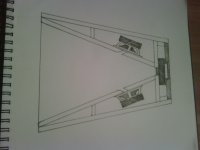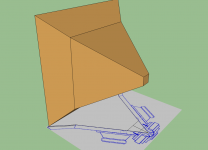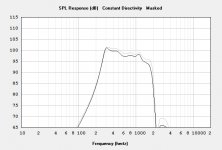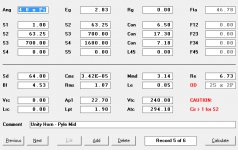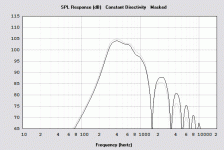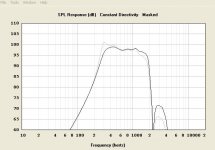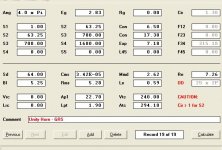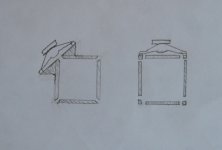One other comment. If you do a Unity horn with ribbons, one option is to put theme somewhere OTHER than the apex.
The whole idea of a unity is that we DON'T have to drive a horn at the apex. There is nothing stopping us from driving a horn from a point down the throat.
For example, instead of using a single NEO 3 at the apex of the horn, you can use *two* NEO 3s, and sandwich them face-to-face.
If you are following me here, you'll see that the "NEO 3 sandwich" would have a gap of zero inches on one edge, and perhaps one inch on the other.
By making the gap in your NEO 3 sandwich very small, you push standing waves up in frequency, to a point where they're inaudible.
Of course, this begs the question, how do you mount two square ribbons to the edge of a pyramid-shaped horn?
And the answer is that you simply create a very shallow cavity in front of the part of the diaphragm that doesn't fit on the pyramid. As long as the depth of that cavity is very shallow, the standing waves will be above audibility.
It's the same idea as what I did with a single ribbon, but instead of using a throat that's 1" in diameter, the throat of the horn is just a fraction of an in inch.
The horn would look like this from the outside (IE, there's basically no throat - it's a fraction of an inch.)
The horn would also be simpler to fabricate, since it's a simple wooden pyramid with two ribbons slapped onto the sides at the very top of the pyramid. While the idea of running dual tweeters may seem non-intuitive, it will totally work as long as you keep them very close together. With a gap of 1/4" you wont get interference until 14000hz, and in the real world, I'll bet it wouldn't happen til 28000hz really. And obviously, dual ribbons increases power handling and efficiency. If you *did* get interference, a simple fifty cent inductor can roll off one ribbon above 14000hz, and would eliminate interference while retaining high power handling and efficiency from 1000hz to 14000hz.
The biggest synergy horn uses dual tweeters BTW
The whole idea of a unity is that we DON'T have to drive a horn at the apex. There is nothing stopping us from driving a horn from a point down the throat.
For example, instead of using a single NEO 3 at the apex of the horn, you can use *two* NEO 3s, and sandwich them face-to-face.
If you are following me here, you'll see that the "NEO 3 sandwich" would have a gap of zero inches on one edge, and perhaps one inch on the other.
By making the gap in your NEO 3 sandwich very small, you push standing waves up in frequency, to a point where they're inaudible.
Of course, this begs the question, how do you mount two square ribbons to the edge of a pyramid-shaped horn?
And the answer is that you simply create a very shallow cavity in front of the part of the diaphragm that doesn't fit on the pyramid. As long as the depth of that cavity is very shallow, the standing waves will be above audibility.
It's the same idea as what I did with a single ribbon, but instead of using a throat that's 1" in diameter, the throat of the horn is just a fraction of an in inch.
The horn would look like this from the outside (IE, there's basically no throat - it's a fraction of an inch.)
An externally hosted image should be here but it was not working when we last tested it.
The horn would also be simpler to fabricate, since it's a simple wooden pyramid with two ribbons slapped onto the sides at the very top of the pyramid. While the idea of running dual tweeters may seem non-intuitive, it will totally work as long as you keep them very close together. With a gap of 1/4" you wont get interference until 14000hz, and in the real world, I'll bet it wouldn't happen til 28000hz really. And obviously, dual ribbons increases power handling and efficiency. If you *did* get interference, a simple fifty cent inductor can roll off one ribbon above 14000hz, and would eliminate interference while retaining high power handling and efficiency from 1000hz to 14000hz.
The biggest synergy horn uses dual tweeters BTW
Last edited:
Once I got the compression drivers and mids in I discovered that what I had modeled in Akabak was not physically possible. I’ve had little time to rework the script to reflect the real world measurements of the components. I hope to get moving as my work settles down again. I’ve been on reassignment for two months because another department can’t seem to get their crap together. I still plan to have a working Synergy horn by winter.
I've been following yours and others progress with unity/synergy horns for some time now, and I can hardly wait to see the results. It seems there's been a handful of successful DIY attempts, but as of yet there hasn't been a fully documented build within the reach of an "average" DIY'er. I'm just popping in to say I appreciate your willingness to share your work and when you finally finish I will be one of the first to make sawdust!
I have some eminence psd -2002 comp drivers and will be getting (4) eminence alpha-8MRA's soon , they seem to have the proper characteristics for a bandpass configuration for 2 unity horns. Just don't know how the large mid port will affect the passing wave from the CD. I will be putting a slot port for the mids on the top and bottom of the horn within a 1/4 wl of the CD for 1500hz x-over. The mouth is 24" wide and 18" high, and the box is 25" deep. Coverage is 41 deg vertical and 55 deg horizontal . I will have some pics when I am further along.
Attachments
Interesting ideas. I haven't even thought of compression loading the ribbons.
Alright, after disassembling my ribbon tweeter I decide to order one of these:
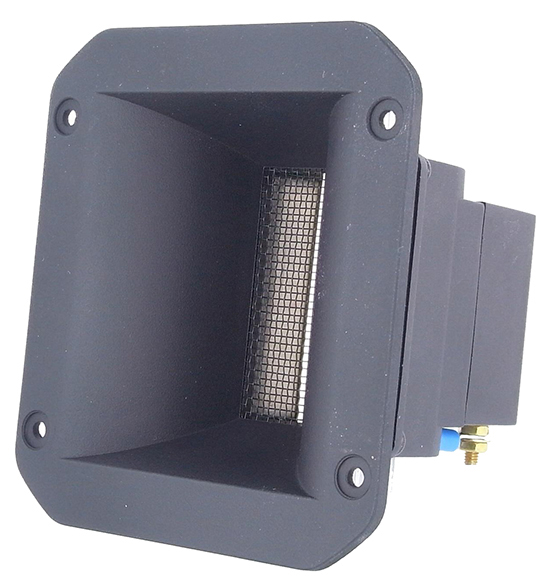
The one that I have is from Creative Sound, and appears to be a re-branded Aurum Cantus APR 2.1
Aurum Cantus APR2.1 Ribbon Tweeter
Fountek "claims" you can cross their ribbon over at 1100hz, and I was able to run the Aurum Cantus down to about 1khz on a waveguide. (Then it exploded lol)
The Fountek is about 40% cheaper and the diaphragm is twice as heavy, so hopefully it can take punishment better than the APR 2.1.
I'll keep my fingers crossed and if I can find the time to build it, maybe we'll see a Unity horn with a ribbon at the apex
Stay tuned...
Pyle PDMR5 vs Misco JC5RTF-B
So, I've been trying to find a suitable 5" replacement for the Misco JC5RTF-B that is assumed to be the stock driver in the original AE Unity kit. The Pyle PDMR5 gets pretty darn close, but would require a crossover redesign. Using the measurements and details from William Cowan's site, I've designed a Sketchup clone to infer the dimensions from. I've modeled them both in HornResp, and it seems the Pyle has a nearly identical response but just 2db less sensitive EXCEPT for the peak at cutoff (Gray is Misco, Black is Pyle). Is there something I'm missing?
I'm seriously considering just building one and running it active with the Pyle mids and a Selenium D220Ti. Maybe once it's all built I could take measurements and get some help with a passive crossover. I've just got to have one! (but I'll wait if someone's got a better idea )
)
So, I've been trying to find a suitable 5" replacement for the Misco JC5RTF-B that is assumed to be the stock driver in the original AE Unity kit. The Pyle PDMR5 gets pretty darn close, but would require a crossover redesign. Using the measurements and details from William Cowan's site, I've designed a Sketchup clone to infer the dimensions from. I've modeled them both in HornResp, and it seems the Pyle has a nearly identical response but just 2db less sensitive EXCEPT for the peak at cutoff (Gray is Misco, Black is Pyle). Is there something I'm missing?
I'm seriously considering just building one and running it active with the Pyle mids and a Selenium D220Ti. Maybe once it's all built I could take measurements and get some help with a passive crossover. I've just got to have one! (but I'll wait if someone's got a better idea
Attachments
What about using delay on the 8"ers to align the outputs even if the 8"port slot is further away than 1/4 WL?
Since they're firing into a common horn, my SWAG is that the physical delay [offset] will be far enough out of sync with the electrical delay to not work well enough, but only one way to know for sure.
GM
It is very interesting that the Pyle might work. A few years ago I proposed using it*, but at the time I don't think the T/S params were available. And I've already tested a bunch of drivers and didn't need to add more to the pile. (pyle?)
Looks like Paul Spencer convinced Parts Express to test them, and it is indeed a good candidate:
Pyle Pro PDMR5 5" Sealed Back Midrange Customer Questions and Answers
One nice thing about the Pyle, versus the ones I used, is that you don't have to seal off the basket. I found that sealing the basket is a lot trickier than it looks, particularly since some drivers just wont do it properly. It's a real p.i.t.a. to seal off those 2" midranges that I used.
* http://www.diyaudio.com/forums/multi-way/117537-another-unity-horn-22.html#post1670582
Looks like Paul Spencer convinced Parts Express to test them, and it is indeed a good candidate:
Pyle Pro PDMR5 5" Sealed Back Midrange Customer Questions and Answers
One nice thing about the Pyle, versus the ones I used, is that you don't have to seal off the basket. I found that sealing the basket is a lot trickier than it looks, particularly since some drivers just wont do it properly. It's a real p.i.t.a. to seal off those 2" midranges that I used.
* http://www.diyaudio.com/forums/multi-way/117537-another-unity-horn-22.html#post1670582
I had shot Misco an email to find out if they would sell them - haven't heard from them yet.
Patrick, do you have any leftover from your box that you don't need?
-Jim
These Pyles are pretty darn tempting. I was planning on using the Misco for my Unity horn clone, and the Danley crossover from Cowan's site for the midrange, and my own crossover for the ribbon tweeter.
This assumes that it's possible to get the ribbon to play down to where the mids come in, and the jury is still out on that. I just went outside to see if FedEx brought me my ribbons yet
But the Pyle is so darn close, it might be a better choice. The Misco is a bit better, but is hard to get, and costs more. I can't see any real good reason to use it, unless the measured specs from Parts Express are wrong.
I think that the smaller midranges are a better candidate for a hifi unity horn, because you can get them to play a bit higher, but sealing off the basket is a real hassle. It would also be nice if we could come up with a design which didn't require people to do this, because if people have to seal off the basket and they do it wrong, the speaker won't work properly.
Looks like Paul Spencer convinced Parts Express to test them, and it is indeed a good candidate
Looks close enough to me, theoretically just needing a bit more shelving [Pyle in shadow]:
GM
Attachments
Hold the show!
A few days ago I asked for T/S measurements of the GRS 5SBM-8 5" sealed mid and now they are listed in the answer section.
I plugged them into Hornresp and Isn't that the prettiest plot you've ever seen (Pyle in gray, GRS in black)! Now, they've got a metal grill that would need to be pried off, but I can deal with that at $5 a pop.
Isn't that the prettiest plot you've ever seen (Pyle in gray, GRS in black)! Now, they've got a metal grill that would need to be pried off, but I can deal with that at $5 a pop.
GM - would you mind posting your Hornresp input parameters? The overall shape looks similar to mine, but there's definitely some differences. I'd like to see if I've got something wrong.
A few days ago I asked for T/S measurements of the GRS 5SBM-8 5" sealed mid and now they are listed in the answer section.
I plugged them into Hornresp and
GM - would you mind posting your Hornresp input parameters? The overall shape looks similar to mine, but there's definitely some differences. I'd like to see if I've got something wrong.
Attachments
(but I'll wait if someone's got a better idea)
In a different vein: The mids are mounted on the flat of the horn, because that's easy. But it's not much harder to mount them on the corner of the WG (which I intend to do, when I get around to modifying my Unity horns). That way you can use a single entry hole (or slot) right in the corner. And you can move the mids a bit closer to the apex. Cross section:
Attachments
A few days ago I asked for T/S measurements of the GRS 5SBM-8 5" sealed mid and now they are listed in the answer section.
I plugged them into Hornresp andIsn't that the prettiest plot you've ever seen (Pyle in gray, GRS in black)! Now, they've got a metal grill that would need to be pried off, but I can deal with that at $5 a pop.
GM - would you mind posting your Hornresp input parameters? The overall shape looks similar to mine, but there's definitely some differences. I'd like to see if I've got something wrong.
It's all a bit embarassing that Mark Seaton's advice from five years ago was ignored by yours truly. He basically said "find any ol' small closed back midrange." I recall that he specifically told me that the back chamber on my original project was too large, and that the Eminence closed back midranges for line array use look like good candidates.
I should stop doing so many sims and start making more sawdust
Misco pretty much makes things as they are ordered. Like most companies today, they use the "Just Too Late" inventory strategy. While PE has been posting some T/S parameters, they've failed to provide Vas. You're gonna need Vas to do a proper simulation. Lastly, I'd never consider ever using a mid that has a rubber or foam surround for a Unity/Synergy horn. The misco RDC3TA is proving to be a very good choice. I've been doing testing with it, but not ready to put any additional info out right now.
- Home
- Loudspeakers
- Multi-Way
- Suitable midrange cone, for bandpass mid in Unity horn.
